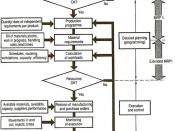Enterprise Resource Planning--- Measuring the Costs and Benefits Is ERP Worth the Pain? By Daniel Keefe Executives have been trying to integrate the people, technology, products and processes of an organization in an attempt to maximize the productive resources of the manufacturing enterprise. In the 50s and 60s, Planning and Inventory Control Systems ruled the day. In the 70s, Materials management systems (MRP) were added, incorporating other aspects to the planning and inventory processes. In the 80s, MRP evolved into MRP II, incorporating other manufacturing processes in addition to financial functions. Finally, the 90s saw an extension to MRP II. ERP was created to integrate all aspects (Manufacturing, Finance, Engineering, Sales, Marketing, and Human Resources) of an enterprise. Often, the Enterprise Resource Planning is a natural extension or evolution of MRP or MRP II sub systems.
Today's, ERP systems act more as decision support systems than just data and transaction processing systems.
This is reinforced by the fact that ERP can accommodate any type of company, including non-manufacturing or service type companies. In the next five years, the growth of the ERP market is expected to increase to a 52 billion market from the current $11 billion, a 37% annual rate. Many companies have spent enormous resources on implementing ERP systems or extended their MRP system to a more encompassing ERP system. In this ever-changing business and technological environment, CEOs and CFOs are having a hard time deciding to go ERP because of the enormous capital expense and the effects on the company as a whole.
The average implementation cost for a company is $15 million. For many small companies, a cost expenditure of this magnitude is a make or break decision for a company. For the decision-maker of a company, the cost can total the entire IT...


